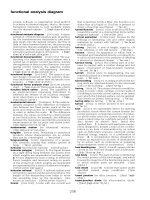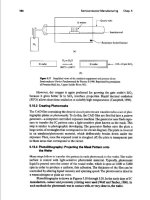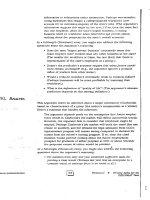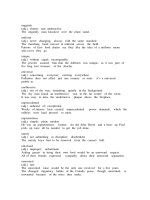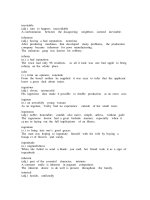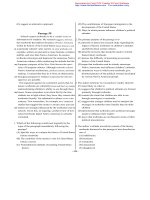GMAT reading Episode 2 Part 1 pps
Bạn đang xem bản rút gọn của tài liệu. Xem và tải ngay bản đầy đủ của tài liệu tại đây (159.29 KB, 10 trang )
- 61 -
(D) Ⅰ ,Ⅱ , and Ⅳ only
(E) Ⅰ ,Ⅲ , and Ⅳ only
7. The passage suggests that because Weddell seals are
forcibly submerged during laboratory dives, they do
which of the following?
(A) Exhibit the physiological responses that are
characteristic of dives in the wild that last less than
twenty minutes.
(B) Exhibit the physiological responses that are
characteristic of the longer dives they undertake in
the wild.
(C) Cope with oxygen deprivation less effectively than
they do on typical dives in the wild.
(D) Produce smaller amounts of lactic acid than they do
on typical dives in the wild.
(E) Navigate less effectively than they do on typical
dives in the wild
Passage 30
Since the early 1970’s, historians have begun to
devote serious attention to the working class in the
United States. Yet while we now have studies of
working-class communities and culture, we know
(5)
remarkably little of worklessness. When historians have
paid any attention at all to unemployment, they have
focused on the Great Depression of the 1930’s. The
narrowness of this perspective ignores the pervasive
recessions and joblessness of the previous decades, as
(10
)
Alexander Keyssar shows in his recent book.
Examining
the period 1870-1920, Keyssar concentrates on Massa-
chusetts, where the historical materials are particularly
rich, and the findings applicable to other industrial
areas.
(15 )
The unemployment rates that Keyssar calculates
appear to be relatively modest, at least by Great Depres-
sion standards: during the worst years, in the 1870’s
and 1890’s, unemployment was around 15 percent. Yet
Keyssar rightly understands that a better way to
(20)
measure the impact of unemployment is to calculate
unemployment frequencies—measuring the percentage
of workers who experience any unemployment in the
course of a year. Given this perspective, joblessness
looms much larger.
(25)
Keyssar also scrutinizes unemployment patterns
according to skill level, ethnicity, race, age, class, and
gender. He finds that rates of joblessness differed
primarily according to class: those in middle-class and
white-collar occupations were far less likely to be unem-
(30)
ployed. Yet the impact of unemployment on a specific
class was not always the same. Even when dependent on
the same trade, adjoining communities could have
dramatically different unemployment rates. Keyssar uses
these differential rates to help explain a phenomenon
(35)
that has puzzled historians—the startlingly high rate of
geographical mobility in the nineteenth-century United
States. But mobility was not the dominant working-class
strategy for coping with unemployment, nor was assis-
tance from private charities or state agencies. Self-help
(40)
and the help of kin got most workers through jobless
spells.
While Keyssar might have spent more time develop-
ing the implications of his findings on joblessness for
contemporary public policy, his study, in its thorough
(45)
research and creative use of quantitative and qualitative
evidence, is a model of historical analysis.
1. The passage is primarily concerned with
(A) recommending a new course of investigation
(B) summarizing and assessing a study
(C) making distinctions among categories
(D) criticizing the current state of a field
(E) comparing and contrasting two methods for
calculating data
2. The passage suggests that before the early 1970’s, which
of the following was true of the study by historians of
the working class in the United States?
(A) The study was infrequent or superficial, or both.
(B) The study was repeatedly criticized for its allegedly
Generated by Foxit PDF Creator © Foxit Software
For evaluation only.
- 62 -
narrow focus.
(C) The study relied more on qualitative than
quantitative evidence.
(D) The study focused more on the working-class
community than on working-class culture.
(E) The study ignored working-class joblessness during
the Great Depression.
3. According to the passage, which of the following is true
of Keyssar’s findings concerning unemployment in
Massachusetts?
(A) They tend to contradict earlier findings about such
unemployment.
(B) They are possible because Massachusetts has the
most easily accessible historical records.
(C) They are the first to mention the existence of high
rates of geographical mobility in the nineteenth
century.
(D) They are relevant to a historical understanding of
the nature of unemployment in other states.
(E) They have caused historians to reconsider the role of
the working class during the Great Depression.
4. According to the passage, which of the following is true
of the unemployment rates mentioned in line 15
(A) They hovered, on average, around 15 percent during
the period 1870-1920.
(B) They give less than a full sense of the impact of
unemployment on working-class people.
(C) They overestimate the importance of middle class
and white-collar unemployment.
(D) They have been considered by many historians to
underestimate the extent of working-class
unemployment.
(E) They are more open to question when calculated for
years other than those of peak recession.
5. Which of the following statements about the
unemployment rate during the Great Depression can be
inferred from the passage?
(A) It was sometimes higher than 15 percent.
(B) It has been analyzed seriously only since the early
1970’s.
(C) It can be calculated more easily than can
unemployment frequency.
(D) It was never as high as the rate during the 1870’s.
(E) It has been shown by Keyssar to be lower than
previously thought.
6. According to the passage, Keyssar considers which of
the
following to be among the important predictors of the
likelihood that a particular person would be unemployed
in
late nineteenth-century Massachusetts?
Ⅰ . The person’s class
Ⅱ . Where the person lived or worked
Ⅲ . The person’s age
(A) Ⅰ only
(B) Ⅱ only
(C) Ⅰ and Ⅱ only
(D) Ⅰ and Ⅲ only
(E) Ⅰ ,Ⅱ , and Ⅲ
7. The author views Keyssar’s study with
(A) impatient disapproval
(B) wary concern
(C) polite skepticism
(D) scrupulous neutrality
(E) qualified admiration
8. Which of the following, if true, would most strongly
support Keyssar’s findings as they are described by the
author?
Generated by Foxit PDF Creator © Foxit Software
For evaluation only.
- 63 -
(A) Boston, Massachusetts, and Quincy, Massachusetts,
adjoining communities, had a higher rate of
unemployment for working-class people in 1870
than in 1890.
(B) White-collar professionals such as attorneys had as
much trouble as day laborers in maintaining a steady
level of employment throughout the period 1870-
1920.
(C) Working-class women living in Cambridge,
Massachusetts, were more likely than working-class
men living in Cambridge to be unemployed for some
period of time during the year 1873.
(D) In the 1890’s, shoe-factory workers moved away in
large numbers from Chelmsford, Massachusetts,
where shoe factories were being replaced by other
industries, to adjoining West Chelmsford, where the
shoe industry flourished.
(E) In the late nineteenth century, workers of all classes
in Massachusetts were more likely than workers of all
classes in other states to move their place of
residence from one location to another within the
state.
Passage 31
The number of women directors appointed to corpo-
rate boards in the United States has increased dramati-
cally, but the ratio of female to male directors remains
low. Although pressure to recruit women directors,
(5
)
unlike that to employ women in the general work force,
does not derive from legislation, it is nevertheless real.
Although small companies were the first to have
women directors, large corporations currently have a
higher percentage of women on their boards. When the
(10)
chairs of these large corporations began recruiting
women to serve on boards, they initially sought women
who were chief executive officers
(CEO’s)
of
large corpo-
rations. However, such women CEO’s are still rare. In
addition, the ideal of six CEO’s (female or male )
serving
(15)
on the board of each of the largest corporations is
realiz-
able only if every CEO serves on six boards. This
raises
the specter of director overcommitment and the
resultant
dilution of contribution. Consequently, the chairs next
sought women in business who had the equivalent of
(20)
CEO experience. However, since it is only recently
that
large numbers of women have begun to rise in
manage-
ment, the chairs began to recruit women of high
achieve-
ment outside the business world. Many such women
are
well known for their contributions in government,
(25)
education, and the nonprofit sector. The fact that the
women from these sectors who were appointed were
often acquaintances of the boards’ chairs seems quite
reasonable: chairs have always considered it important
for directors to interact comfortably in the boardroom.
30)
Although many successful women from outside
the
business world are unknown to corporate leaders,
these
women are particularly qualified to serve on boards
because of the changing nature of corporations. Today
a
company’s ability to be responsive to the concerns of
the
35)
community and the environment can influence that
company’s growth and survival. Women are uniquely
positioned to be responsive to some of these concerns.
Although conditions have changed, it should be
remem-
bered that most directors of both sexes are over fifty
(40)
years old. Women of that generation were often
encour-
aged to direct their attention toward efforts to improve
the community. This fact is reflected in the career
devel-
Generated by Foxit PDF Creator © Foxit Software
For evaluation only.
- 64 -
opment of most of the outstandingly successful
women
of the generation now in their fifties, who currently
serve
(45)
on corporate boards: 25 percent are in education and
22 percent are in government, law, and the nonprofit
sector.
One organization of women directors is helping busi-
ness become more responsive to the changing needs of
(50)
society by raising the level of corporate awareness
about
social issues, such as problems with the economy,
government regulation, the aging population, and the
environment. This organization also serves as a resource
center of information on accomplished women who are
(55)
potential candidates for corporate boards.
1. The author of the passage would be most likely to agree
with which of the following statements about
achievement of the “ideal” mentioned in line 14?
(A) It has only recently become a possibility.
(B) It would be easier to meet if more CEO’s were
women
(C) It is very close to being a reality for most corporate
boards.
(D) It might affect the quality of directors’ service to
corporations.
(E) It would be more realizable if CEO’s had a more
extensive range of business experience.
2. According to the passage, the pressure to appoint
women to corporate boards differs from the pressure to
employ women in the work force in which of the
following ways?
(A) Corporate boards are under less pressure because
they
have such a small number of openings.
(B) Corporate boards have received less pressure from
stockholders, consumers, and workers within
companies to include women on their boards.
(C) Corporate boards have received less pressure from
the media and the public to include women on their
boards.
(D) Corporations have only recently been pressured to
include women on their boards.
(E) Corporations are not subject to statutory penalty for
failing to include women on their boards.
3. All of the following are examples of issues that the
organization described in the last paragraph would be
likely to advise corporations on EXCEPT
(A) long-term inflation
(B) health and safety regulations
(C) retirement and pension programs
(D) the energy shortage
(E) how to develop new markets
4. It can be inferred from the passage that, when seeking to
appoint new members to a corporation’s board, the chair
traditionally looked for candidates who
(A) had legal and governmental experience
(B) had experience dealing with community affairs
(C) could work easily with other members of the board
(D) were already involved in establishing policy for that
corporation
(E) had influential connections outside the business
world
5. According to the passage, which of the following is true
about women outside the business world who are
currently serving on corporate boards?
(A) Most do not serve on more than one board.
(B) A large percentage will eventually work on the staff
of corporations.
(C) Most were already known to the chairs of the board
to which they were appointed.
(D) A larger percentage are from government and law
than are from the nonprofit sector.
(E) Most are less than fifty years old.
6. The passage suggests that corporations of the past differ
from modern corporations in which of the following
Generated by Foxit PDF Creator © Foxit Software
For evaluation only.
- 65 -
ways?
(A) Corporations had greater input on government
policies affecting the business community.
(B) Corporations were less responsive to the financial
needs of their employees.
(C) The ability of a corporation to keep up with
changing markets was not a crucial factor in its
success.
(D) A corporation’s effectiveness in coping with
community needs was less likely to affect its growth
and prosperity.
(E) Corporations were subject to more stringent
government regulations.
7. Which of the following best describes the organization
of the passage?
(A) A problem is described, and then reasons why
various proposed solutions succeeded or failed are
discussed.
(B) A problem is described, and then an advantage of
resolving it is offered.
(C) A problem is described, and then reasons for its
continuing existence are summarized.
(D) The historical origins of a problem are described,
and then various measures that have successfully
resolved it are discussed.
(E) The causes of a problem are described, and then its
effects are discussed.
8. It can be inferred from the passage that factors making
women uniquely valuable members of modern corporate
boards would include which of the following?
Ⅰ . The nature of modern corporations
Ⅱ . The increased number of women CEO’s
Ⅲ . The careers pursued by women currently available to
serve on corporate boards
(A) Ⅰ only
(B) Ⅱ only
(C) Ⅲ only
(D) Ⅰ and Ⅲ only
(E) Ⅰ ,Ⅱ , and Ⅲ
Passage 32
Increasingly, historians are blaming diseases
imported
from the Old World for the staggering disparity between
the indigenous population of America in 1492—
new esti-
mates of which soar as high as 100 million, or approxi-
(5)
mately one-sixth of the human race at that time—and
the few million full-blooded Native Americans alive at
the end of the nineteenth century. There is no doubt that
chronic disease was an important factor in the precipi-
tous decline, and it is highly probable that the greatest
(10)
killer was epidemic disease, especially as manifested in
virgin-soil epidemics.
Virgin-soil epidemics are those in which the popula-
tions at risk have had no previous contact with the
diseases that strike them and are therefore immunologi-
(15)
cally almost defenseless. That
virgin-soil epidemics were
important in American history is strongly indicated by
evidence that a number of dangerous maladies—small-
pox, measles, malaria, yellow fever, and undoubtedly
several more—were unknown in the pre-Columbian
(20)
New World. The effects of their sudden introduction
are demonstrated in the early chronicles of America,
which contain reports of horrendous epidemics
and steep
population declines, confirmed in many cases by recent
quantitative analyses of Spanish tribute records and
(25)
other sources. The evidence provided by the documents
of British and French colonies is not as definitive
because the conquerors of those areas did not establish
permanent settlements and begin to keep continuous
records until the seventeenth century, by which
time the
(30)
worst epidemics had probably already taken place.
Generated by Foxit PDF Creator © Foxit Software
For evaluation only.
- 66 -
Furthermore, the British tended to drive the native
populations away, rather than enslaving them as the
Spaniards did, so that the epidemics of British America
occurred beyond the range of colonists’ direct
(35)
observation.
Even so, the surviving records of North America do
contain references to deadly epidemics among
the indige
-
nous population. In 1616-1619 an epidemic,
possibly of
bubonic or pneumonic plague, swept coastal New
(40
)
England, killing as many as nine out of ten. During the
1630’s smallpox, the disease most fatal to the Native
American people, eliminated half the population of the
Huron and Iroquois confederations. In the 1820’s fever
devastated the people of the Columbia River area,
(45)
killing eight out of ten of them.
Unfortunately, the documentation of these and other
epidemics is slight and frequently unreliable, and it is
ecessary to supplement what little we do know with
evidence from recent epidemics among Native Ameri-
(50)
cans. For example, in 1952 an outbreak of measles
among the Native American inhabitants of
Ungava Bay.
Quebec, affected 99 percent of the population
and killed
7 percent, even though some had the benefit of modern
medicine. Cases such as this demonstrate that even
(55)
diseases that are not normally fatal can
have devastating
consequences when they strike an immunologically
defenseless community.
1. The primary purpose of the passage is to
(A) refute a common misconception
(B) provide support for a hypothesis
(C) analyze an argument
(D) suggest a solution to a dilemma
(E) reconcile opposing viewpoints
2. According to the passage, virgin-soil epidemics can be
distinguished from other catastrophic outbreaks of
disease in that virgin-soil epidemics
(A) recur more frequently than other chronic diseases
(B) affect a minimum of one-half of a given population
(C) involve populations with no prior exposure to a
disease
(D) usually involve a number of interacting diseases
(E) are less responsive to medical treatment than are
other diseases
3. According to the passage, the British colonists
wereunlike the Spanish colonists in that the British
colonists
(A) collected tribute from the native population
(B) kept records from a very early date
(C) drove Native Americans off the land
(D) were unable to provide medical care against
epidemic disease
(E) enslaved the native populations in America
4. Which of the following can be inferred from the passage
concerning Spanish tribute records?
(A) They mention only epidemics of smallpox.
(B) They were instituted in 1492.
(C) They were being kept prior to the seventeenth
century.
(D) They provide quantitative and qualitative evidence
about Native American populations.
(E) They prove that certain diseases were unknown in
the pre-Columbian New World.
5. The author implies which of the following about
measles?
(A) It is not usually a fatal disease.
(B) It ceased to be a problem by the seventeenth century.
(C) It is the disease most commonly involved in virgin-
soil epidemics.
(D) It was not a significant problem in Spanish colonies.
(E) It affects only those who are immunologically
defenseless against it.
6. Which of the following can be inferred from the passage
about the Native American inhabitants of Ungava Bay?
(A) They were almost all killed by the 1952 epidemic.
(B) They were immunologically defenseless against
measles.
Generated by Foxit PDF Creator © Foxit Software
For evaluation only.
- 67 -
(C) They were the last native people to be struck by a
virgin- soil epidemic.
(D) They did not come into frequent contact with white
Americans until the twentieth century.
(E) They had been inoculated against measles.
7. The author mentions the 1952 measles outbreak most
probably in order to
(A) demonstrate the impact of modern medicine on
epidemic disease
(B) corroborate the documentary evidence of epidemic
disease in colonial America
(C) refute allegations of unreliability made against the
historical record of colonial America
(D) advocate new research into the continuing problem
of epidemic disease
(E) challenge assumptions about how the statistical
evidence of epidemics should be interpreted
8. Which of the following, if newly discovered, would
most seriously weaken the author’s argument
concerning the importance of virgin-soil epidemics in
the depopulation of Native Americans?
(A) Evidence setting the pre-Columbian population of
the New World at only 80 million
(B) Spanish tribute records showing periodic population
fluctuations
(C) Documents detailing sophisticated Native American
medical procedures
(D) Fossils indicating Native American cortact with
smallpox prior to 1492
(E) Remains of French settlements dating back to the
sixteenth century
Passage 33
Until recently most astronomers believed that the
space between the galaxies in our universe was a near-
perfect vacuum. This orthodox view of the universe is
now being challenged by astronomers who believe
that a
(5)
heavy “rain” of gas is falling into many galaxies from
the supposedly empty space around them. The gas
apparently condenses into a collection of small stars,
each a little larger than the planet Jupiter. These stars
vastly outnumber the other stars in a given galaxy. The
(10)
amount of “intergalactic rainfall” into some of these
galaxies has been enough to double their mass in the
time since they formed. Scientists have
begun to suspect
that this intergalactic gas is probably a mixture of gases
left over from the “big bang” when the galaxies were
(15)
formed and gas was forced out of galaxies
by supernova
explosions.
It is well known that when gas is cooled at a constant
pressure its volume decreases. Thus, the
physicist Fabian
reasoned that as intergalactic gas cools, the cooler gas
(20)
shrinks inward toward the center of the galaxy. Mean-
while its place is taken by hotter intergalactic gas from
farther out on the edge of the galaxy, which cools as it is
compressed and flows into the galaxy. The net result is a
continuous flow of gas, starting as hot gases in inter-
(25)
galactic space and ending as a drizzle of cool
gas called a
“cooling flow,” falling into the central galaxy.
A fairly heretical idea in the 1970’s, the cooling-flow
theory gained support when Fabian observed a cluster
of galaxies in the constellation Perseus and found the
(30)
central galaxy, NGC 1275, to be a strange-
looking object
with irregular, thin strands of gas radiating from it.
According to previous speculation, these strands were
gases that had been blown out by an explosion in the
galaxy. Fabian, however, disagreed. Because the
strands
(35)
of gas radiating from NGC 1275 are visible in optical
photographs, Fabian suggested that such strands
consisted
not of gas blown out of the galaxy but of cooling flows
of gas streaming inward. He noted that the wavelengths
of the radiation emitted by a gas would changes as the
(40)
gas cooled, so that as the gas flowed into the galaxy
and
became cooler, it would emit not x-rays, but
visible light
,
like that which was captured in the photographs.
Fabian’s
hypothesis was supported by Canizares’
determination in
1982 that most of the gas in the
Perseus
cluster was at a
(45)
temperature of 80 million degrees Kelvin, whereas the
gas immediately surrounding NGC 1275 (the subject of
Generated by Foxit PDF Creator © Foxit Software
For evaluation only.
- 68 -
the photographs) was at one-tenth this temperature.
1. The primary purpose of the passage is to
(A) illustrate a hypothesis about the origin of galaxies
(B) provide evidence to dispute an accepted theory
about the evolution of galaxies
(C) summarize the state of and prospects for research in
intergalactic astronomy
(D) report new data on the origins of intergalactic gas
(E) reconcile opposing views on the formation of
intergalactic gas
2. The author uses the phrase “orthodox view of the
universe” (line 3) to refer to the belief that
(A) the space between the galaxies is devoid of matter
(B) the space between galaxies is occupied by stars that
cannot be detected by optical photographs
(C) galaxies have decreased in mass by half since their
formation
(D) galaxies contain stars, each the size of Jupiter, which
form clusters
(E) galaxies are being penetrated by gas forced out of
other galaxies by supernova explosions.
3. It can be inferred from the passage that, if Fabian is
correct, gas in the peripheral regions of a galaxy cluster
(A) streams outward into intergalactic space
(B) is hotter than gas in the central regions of the galaxy
(C) is composed primarily of gas left over from the big
bang
(D) results in the creation of unusually large stars
(E) expands to increase the size of the galaxy
4. The author of the passage probably mentions Canizares’
determination in order to
(A) clarify an ambiguity in Fabian’s research findings
(B) illustrate a generalization about the temperature of
gas in a galaxy cluster
(C) introduce a new argument in support of the orthodox
view of galaxies
(D) provide support for Fabian’s assertions about the
Perseus galaxies
(E) provide an alternate point of view concerning the
movement of gas within a galaxy cluster
5. According to the passage, Fabian believes that gas
flowing into a central galaxy has which of the following
characteristics?
(A) It is one-tenth hotter than it was in the outer regions
of the galaxy cluster.
(B) It emits radiation with wavelengths that change as
the gas moves toward the center of the galaxy.
(C) The total amount of radiation emitted diminishes as
the gas cools.
(D) It loses 90 percent of its energy as it moves to the
center of the galaxy.
(E) It condenses at a rate much slower than the rate of
decrease in temperature as the gas flows inward.
6. According to the passage, Fabian’s theory makes use of
which of the following principles?
(A) Gas emanating from an explosion will be hotter the
more distant it is from the origin.
(B) The wavelength of radiation emitted by a gas as it
cools remains constant.
(C) If pressure remains constant, the volume of a gas
will decrease as it is cooled.
(D) The volume of a gas will increase as the pressure
increases.
(E) As gas cools, its density decreases.
7. It can be inferred from the passage that which of the
following is true of Fabian’s theory?
(A) It did not receive approval until Canizares’ work
was published.
(B) It was not widely accepted in the 1970’s.
(C) It did not receive support initially because
technology was not available to confirm its tenets.
(D) It supports earlier speculation that intergalactic gas
was largely the result of explosions outside the
galaxy.
(E) It was widely challenged until x-ray evidence of gas
temperatures in NGC 1275 had been presented.
Generated by Foxit PDF Creator © Foxit Software
For evaluation only.
- 69 -
Passage 34
Kazuko Nakane’s history of the early Japanese immi-
grants to central California’s Pajaro Valley focuses on
the development of farming communities there from
1890 to 1940. The Issei (first-generation immigrants)
(5)
were brought into the Pajaro Valley to raise sugar beets.
Like Issei laborers in American cities, Japanese men in
rural areas sought employment via the “boss” system.
The system comprised three elements: immigrant wage
laborers; Issei boardinghouses where laborers stayed;
(10)
and labor contractors, who gathered workers for a
particular job and then negotiated a contract between
workers and employer. This same system was
originally
utilized by the Chinese laborers who had preceded the
Japanese. A related institution was the “labor club,”
(15)
which provided job information and negotiated employ-
ment contracts and other legal matters, such as the
rental of land, for Issei who chose to belong and
paid an
annual fee to the cooperative for membership.
When the local sugar beet industry collapsed in 1902,
(20)
the Issei began to lease land from the
valley’s strawberry
farmers. The Japanese provided the labor and the crop
was divided between laborers and landowners.
The Issei
began to operate farms, they began to marry and start
families, forming an established Japanese American
(30)
community. Unfortunately, the Issei’s efforts to attain
agricultural independence were hampered by govern-
ment restrictions, such as the Alien Land Law of 1913.
But immigrants could circumvent such
exclusionary laws
by leasing or purchasing land in their American-born
(35)
children’s names.
Nakane’s case study of one rural Japanese American
community provides valuable information about the
lives and experiences of the Isseil. It is, however, too
particularistic. This limitation derives from Nakane’s
(40)
methodology—that of oral history—which cannot
substitute for a broader theoretical or comparative
perspective. Furture research might well consider two
issues raised by her study: were the Issei of the Pajaro
Valley similar to or different from Issei in urban
settings
,
(45)
and what variations existed between rural Japanese
American communities?
1. The primary purpose of the passage is to
(A) defend a controversial hypothesis presented in a
history of early Japanese immigrants to Califronia
(B) dismiss a history of an early Japanese settlement in
California as narrow and ill constructed
(C) summarize and critique a history of an early
Japanese settlement in California
(D) compare a history of one Japanese American
community with studies of Japanese settlements
throughout California
(E) examine the differences between Japanese and
Chinese immigrants to central California in the
1890’s
2. Which of the following best describes a “labor club,” as
defined in the passage?
(A) An organization to which Issei were compelled to
belong if they sought employment in the Pajaro
Valley
(B) An association whose members included labor
contractors and landowning “bosses”
(C) A type of farming corporation set up by Issei who
had resided in the Pajaro Valley for some time
(D) A cooperative association whose members were
dues-paying Japanese laborers
(E) A social organization to which Japanese laborers and
their families belonged
3. Based on information in the passage, which of the
following statements concerning the Alien Land Law of
1913 is most accurate?
(A) It excluded American-born citizens of Japanese
ancestry from landownership.
(B) It sought to restrict the number of foreign
immigrants to California.
(C) It successfully prevented Issei from ever purchasing
Generated by Foxit PDF Creator © Foxit Software
For evaluation only.
- 70 -
farmland.
(D) It was applicable to first-generation immigrants but
not to their American-born children.
(E) It was passed under pressure from the Pajaro
Valley’s strawberry farmers.
4. Several Issei families join together to purchase a
strawberry field and the necessary farming equipment.
Such a situation best exemplifies which of the
following, as it is described in the passage?
(A) A typical sharecropping agreement
(B) A farming corporation
(C) A “labor club”
(D) The “boss” system
(E) Circumvention of the Alien Land Law
5. The passage suggests that which of the following was an
indirect consequence of the collapse of the sugar beet
industry in the Pajaro Valley?
(A) The Issei formed a permanent, family-based
community.
(B) Boardinghouses were built to accommodate the
Issei.
(C) The Issei began to lease land in their children’s
names.
(D) The Issei adopted a labor contract system similar to
that
used by Chinese immigrants.
(E) The Issei suffered a massive dislocation caused by
unemployment.
6. The author of the passage would most likely agree that
which of the following, if it had been included in
Nakane’s study, would best remedy the particularistic
nature of that study?
(A) A statistical table comparing per capita income of
Issei wage laborers and sharecroppers in the Pajaro
Valley
(B) A statistical table showing per capita income of
Issei in the Pajaro Valley from 1890 to 1940
(C) A statistical table showing rates of farm ownership
by Japanese Americans in four central California
counties from 1890 to 1940
(D) A discussion of original company documents
dealing with the Pajaro Valley sugar beet industry at
the turn of the century
(E) Transcripts of interviews conducted with members
of the Pajaro Valley Japanese American community
who were born in the 1920’s and 1930’s.
7. It can be inferred from the passage that, when the Issei
began to lease land from the Valley’s strawberry
farmers, the Issei most probably did which of the
following?
(A) They used profits made from selling the strawberry
crop to hire other Issei.
(B) They negotiated such agricultural contracts using the
“boss” system.
(C) They paid for the use of the land with a share of the
strawberry crop.
(D) They earned higher wages than when they raised
sugar beets.
(E) They violated the Alien Land Law.
Passage 35
It can be argued that much consumer dissatisfaction
with marketing strategies arises from an inability to aim
advertising at only the likely buyers of a given product.
There are three groups of consumers who are affected
(5)
by the marketing process. First, there is the market
segment—people who need the commodity in question.
Second, there is the program target—people in the
market segment with the “best fit” characteristics for a
specific product. Lots of people may need trousers, but
(10
)
only a few qualify as likely buyers of very expensive
designer trousers. Finally, there is the program audience
― all people who are actually exposed to the
marketing program without regard to whether they need
or want the product.
Generated by Foxit PDF Creator © Foxit Software
For evaluation only.
